Contents
ABSTRACT
ABSTRACT
Nanotechnology’s advent and development present an excellent potential to improve the complicated technical issues that food production necessitates. It may bring revolutionary changes to the food production system in the future years. Thus, the goal of this study is to present the current state of nanotechnology in food production. Furthermore, the authors characterize the primary subjects in this study stream, highlight future research potential, and propose a future research plan. This study conducted a bibliometric analysis using data from the Scopus database. The authors are able to retrieve 426 documents for the analysis based on the keywords chosen. The frequency analysis was done using Microsoft Excel, and the citation metrics and analysis were done using R-package software. The findings of this study are reported using standard bibliometric indicators including source title, source type, document type, publication year, subject area, languages, keywords analysis, authorship, citation analysis, geographical distribution, and active institutions. According to our findings, the number of publications on nanotechnology in food production has increased dramatically since 2003. The growing number of studies on nanotechnology demonstrates the relevance of technology in the food sector, which could have implications for the environment, economy, and society.
INTRODUCTION
Nanotechnology is derived from the words ‘nano and technology’. It is a rapidly emerging technology that has the potential to transform the food industry with some astounding applications that may change the traditional methods of food production, processing, packaging, transportation, and consumption. Nanotechnology has emerged as one of the most promising technologies for transforming traditional food science and the food industry. Nanotechnology is known as the study of materials at atomic scales ranging from 1 to 100 nanometers. Literally, the term ‘nano’ refers to ‘molecular size’ (i.e., at a magnitude of 10-9 of a meter). Dervics[1] claimed that nanotechnology was discovered as a research field in the mid-1990s, and rapidly became an important research activity for scientists from a variety of scientific fields. According to the United Nations Educational, Scientific and Cultural Organization (UNESCO) 2030 science report, nanotechnology is a leading technological research priority for developed and developing nations. Furthermore, nanotechnology is a new field of study that will add value to both developing and developed nations. The total number of publications in nanotechnology-related fields has gradually increased over the years globally.
The nano-scaled materials are distinctive in the way that they possess a relatively high specific surface area and unique characteristics which are not attainable by their bulk counterparts.[2] One of the commonly used nanomaterials in the food industry is nano-silver oxide (AgO). The nano-AgO exhibits antibacterial activity, it is able to disrupt and damage the cell integrity of bacteria via the generation of Reactive Oxygen Species (ROS).[3,4] Owing to these unique characteristics, nano-AgO has been widely applied in food packaging. In particular, the incorporation of this nanomaterial in packaging can extend the shelf life of the foods without modifying their quality.[5] Despite that, other nanomaterials such as titanium oxide, zinc oxide, copper oxide, and gold also have been widely used in the food industry.[6,7] Not to mention, the nanotechnology-based sensor has attracted much attention recently in which rapid detection of food contaminants is needed to cope with the food scandal issue.[8]
Today, great efforts are being allotted to the usage of nanotechnology in the food industry. These efforts are even relevant in recent years whereby maintaining food safety against the SARS-CoV-2 virus is crucial.[7–9] Hence, the goal of this paper is to present the pattern of the earlier study on nanotechnology in food production and visualize it with the global development of the field. This article aims to answer the following research questions:
Is there an increase in the number of publications in nanotechnology-food-related studies each year?
Who are the leading researchers in the field of nanotechnology-food-related studies?
Which articles in nanotechnology-food-related have the most citations?
Which scientific journals are widely published in the field of the nanotechnology-food-related field?
What are the most prominently used author keywords in the field of the nanotechnology-food-related field?
Which countries have ranked top in nanotechnology food-related articles and publications?
The findings of this study significantly contributed to academic and industry implications. For the researchers and industry players interested in nanotechnology in the food industry, this study would provide a holistic understanding of the research domain such as key studies, authors, universities, concepts, and methods. Food manufacturers, food traders, business managers, and policymakers can use the identified concepts and methods to enhance coordination among major stakeholders, optimize resource use, and improve food security, safety, and quality performance in sustainable food production.
The remaining parts of this article are organized as follows. First, the authors review the relevant literature on the general introduction of bibliometric analysis and similar research on relevant articles of nanotechnology in food production. After presenting an analytic map of the publications over the last 19 years, it may provide very interesting insight and directions for future research. Second, the authors describe the methods used in this study. The results obtained from the documents gathered in the Scopus database are displayed in the analysis and findings section that follows. Following that, the conclusion section discusses the summary, limitations, and recommendations for future research.
LITERATURE REVIEW
Bibliometric analysis and past studies
Bibliometrics analysis is a strategy used to summarise the state of art in a particular topic via quantitative and statistics analysis.[10] The analysis is normally done by describing patterns of publications in the related topic within a given period. Via bibliometrics analysis, a holistic view of the publication trend related to the number of documents issued through a country, institute, research groups or individuals can be retrieved. Furthermore, a comparison of journals published on the specific topic, as well as the quantity and quality of the published document can be showcased.[10]
According to Durieux and Gevenois,[11] the bibliometric indicators are categorized into quantity, quality, and structural indicators. In particular, the quality indicators determine the publication rate (productivity), the performance of a researcher’s output is determined by quality indicators, and the structural indicators determine the linkage between authors, publications, and research fields. By having this piece of information, a large volume of scientific data can be summarised and later on shed light on the evolution of a specific research area. Recently, Aleixandre-Tudó et al.[12] have applied bibliometric analysis to describe the scientific production related to nanotechnology. Between 1997 and 2018, 3,546 documents were obtained from the Web of Science’s Science Citation Index Expanded (SCIE). Their analysis showed that China was the most productive country and the key cited topics are related to the uses of nanoparticles in biomedical applications, its synthesis from plants, as well as its utilization in food science.
On the other hand, Idamokore and Hosu[13] employed the same technique to analyze the scientific outputs on meat production associated with nanotechnology. Data were retrieved from Web of Science (WOS) and Scopus. From their analysis, it was realized that China, Iran, and India were highly-ranked in the publication of related documents. Their result also showed that an increasing trend (with an annual growth rate of 25.18%) has been observed in this research topic, suggesting an encouraging prospect of this technology. Furthermore, Ribeiro et al.[14] mentioned that bibliometric analysis is perceived as one of the most promising approaches for reviewing trends in a variety of fields, including food science and technology. Apparently, the use of bibliometric analysis to reveal publication trends in the food science and technology field has gained much attention. This fact is supported by Fĺorez-Martínez[15] that bibliometric analysis in the field of food science used primarily to highlight the emergence of scientific research perspectives, challenges, and future trends. As a result, the information provided by this methodology allows us to understand and interpret, from a literature-supported standpoint, publication trends and potential.
METHODOLOGY
Bibliometrics is known as a combination of mathematical and statistical methods to books and other forms of communication that has been widely applied in the field of library and information science studies.[16] The main purpose of conducting bibliometric analysis is to quantitatively evaluate the productivity of scientific outputs. Liang and Liu[17] indicated that statistical tools are needed to conduct bibliometric analysis to analyze past published academic articles in a specific field of study. Bibliometrics includes several descriptive statistics of citation data, and network analysis of authors, journals, universities, countries, and keywords based on citations and frequency analysis techniques. It aids the understanding of research clusters, provides information into current research interests, and reveals patterns for emerging topics in a field. According to Ren et al.,[18] bibliometrics method of review can be used as a new approach to implicitly evaluate developments in recent years and establish relationship networks between publications.
There are four main steps applied in the process of analyzing and mapping bibliographic data. Firstly, starting with data collection through systematic literature search, and comprehensive evaluation of the field. The next steps are to conduct bibliometric citation analysis and network analysis aiming to identify publication trends, the most influential journals, studies, institutions, and authors. Finally, synthesizes findings and discovers potential research direction. Figure 1 represents the methodological flowchart for bibliometric review.
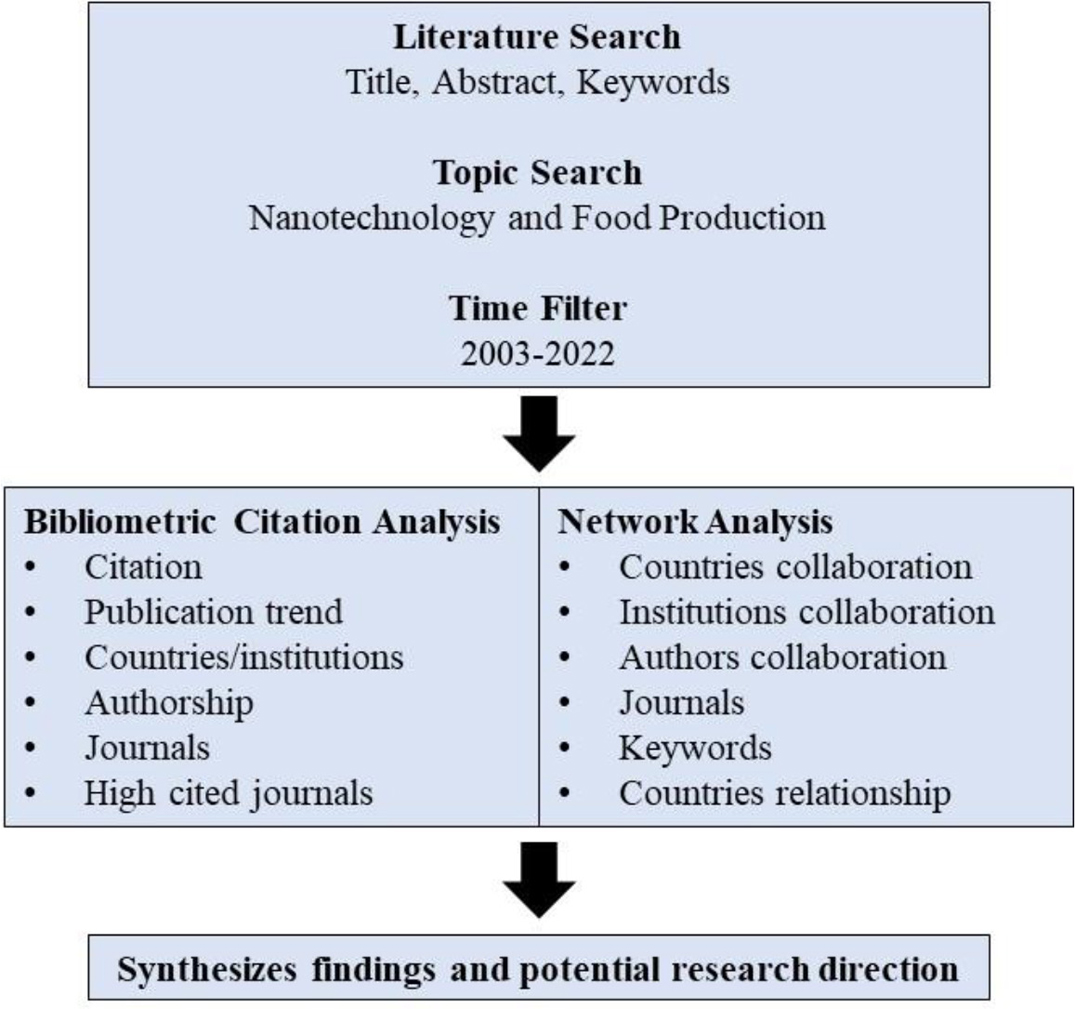
Figure 1:
Methodological flowchart for bibliometric review.
The data for this study comes from the Scopus database as of February 2022, encompassing a time frame extending from 2003 until 2022. This study employs a thorough bibliometric analysis to investigate the evolution and advancement of nanotechnology in the food industry over a 20-year period. The selection of 2003 as the base year was in line with the publication of the first roadmap of nanotechnology into the agriculture and food industry in September 2003 by the United States Department of Agriculture.[19]
Scopus was used as a bibliometric analysis resource in our analysis because it is regarded as the largest citation database and abstracts of peer-reviewed literature by many researchers, compared to Web of Science or PubMed.[14–20] The keywords “nanotechnology” AND “food production” were used to find relevant articles about nanotechnology in food products. The authors concentrate on the titles of the articles since they represent the specific topic that applies to the field of the study and the scope of the research. Past researcher Hong et al.[21] opined that the title of an article includes information that could be used to capture the interest of readers, as it is the first thing they will notice. A total of 426 documents were acquired for the bibliometric analysis based on a Scopus database search, as shown in Figure 2. In this bibliometric study, all 426 documents in the record were screened and included for further analyses. Tools like Microsoft Excel and R-package were utilized to examine the bibliometric analysis. Microsoft Excel is used to determine the frequencies of published materials and to create the appropriate chart and graph, while R-package software is utilized to generate citation metrics and some of the other frequencies.
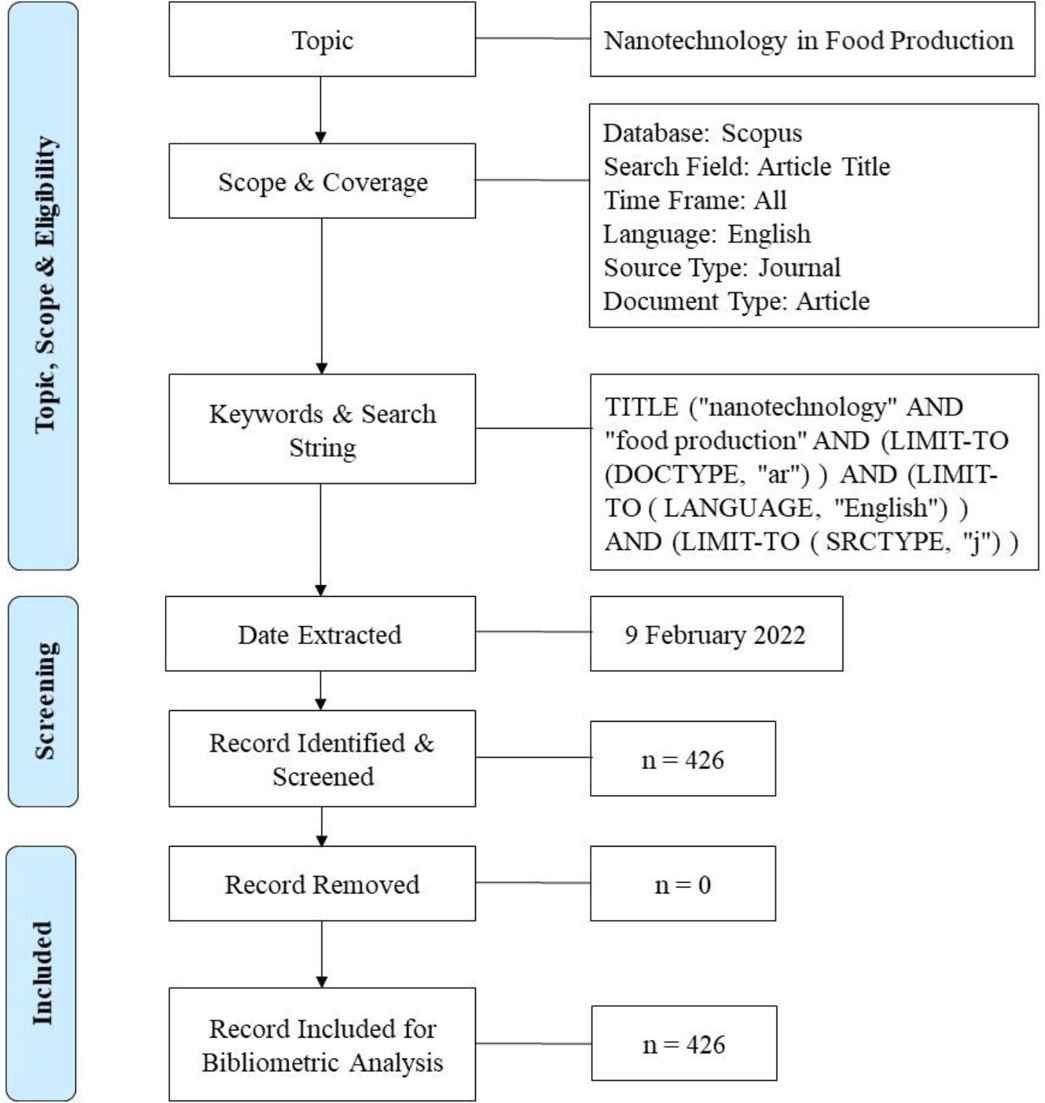
Figure 2:
Flow diagram of the search strategy.
RESULTS AND DISCUSSION
Bibliometric attributes such as source title, source type, document type, publication year, subject area, languages, keywords analysis, authorship, citation analysis, geographical distribution and active institutions using data from the Scopus database. Most of the results and discussions are described as percentages and frequencies. Biblioshiny is used to map the co-occurrence of the author’s keywords, as well as report citation analysis, to identify the top ten most referenced publications in nanotechnology.
Main information
The authors analyze the documents in the Scopus database by document type, source type, and source title. The type of document can be a journal article, a conference paper, a review paper, an article (e.g., magazine, newspaper), a book, a book chapter, or an editorial. Figure 3 represents the document type analyses from this study. Journal articles represent (148; 34.7%) of the articles published in nanotechnology in food production followed by book chapters (128; 30%), and review papers (101; 23.7%). The other document types listed are conference paper (18; 4.2%), book (10; 2.3%), and editorial (8; 1.9%). Both note and erratum have the same total number of publications (5; 2.4%). And the least is erratum with only 3 publications (0.7%). Table 1 contains more general information about the collection of selected articles gleaned from the Biblioshiny tool.
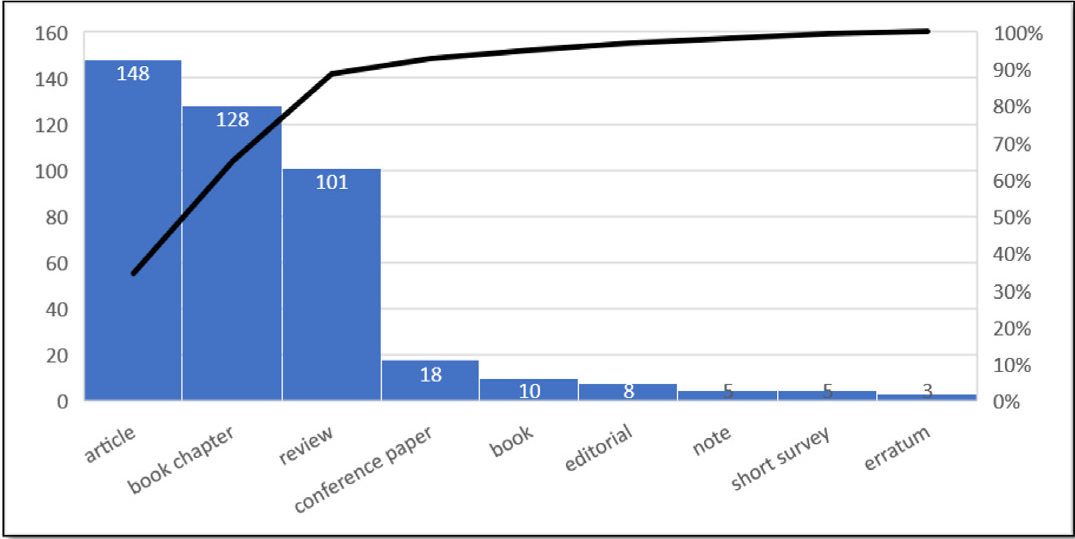
Figure 3:
Document type of the published articles from 2003 till 2022.
| Item | Description | Results |
|---|---|---|
| Main information about data | Timespan | 2003-2022 |
| Sources (Journals, Books, etc) | 271 | |
| Documents | 426 | |
| Average years from publication | 7.39 | |
| Average citations per document | 35.75 | |
| Average citations per year per doc | 3.79 | |
| References | 1 | |
| Authors | Authors | 1,078 |
| Author Appearances | 1,328 | |
| Authors of single-authored documents | 95 | |
| Authors of multi-authored documents | 983 | |
| Authors collaboration | Single-authored documents | 108 |
| Documents per Author | 0.39 | |
| Authors per Document | 2.53 | |
| Co-Authors per Documents | 3.12 | |
| Collaboration Index | 3.09 |
Annual publication trends
The number of articles published on nanotechnology in food production has increased at a rate of 6.29% per year. The first five years (2003-2008) produced 32 publications, compared to 126 in the last five years (2018-2022). Figure 4 depicts the year-to-year publication trend. This demonstrates a growing interest in nanotechnology data and food production research in the food industry. Further analysis had shown that articles published in the early years between 2003 to 2006 mainly focused on the application and potential of nanotechnology in the food industry.[22] As nanotechnology advances, topics such as nanotechnology for food safety, food production, and food processing have been investigated in the last five years. A closer analysis of articles published from 2018 to 2022 showed that topics incorporating nanotechnologies in the food industry, such as nanotechnology innovation in agriculture and food product development, future food production, and food packaging had been examined.[23–25] Apart from these, areas such as the application of nanotechnology to mitigate agriculture risk during postharvest and food security[26] and sustainability of nanotechnology in the food sector[27] had been investigated. This increasing trend in nanotechnology publication topics implies the development of nanotechnology in the food industry for future food systems. It captures the interest of a variety of experts, researchers, practitioners, and academics.

Figure 4:
Year-to-year publication trend.
Most productive authors
Looking at the most productive authors in nanotechnology and food-related research, the current study discovered 1,078 authors who had jointly published a total of 426 articles. A thorough examination revealed that Chaudhry Qasim ranked as the top author, with a total of ten articles. The next contributing authors are Siegrist Micheal and Frewer, Lynn Jayne with 7, and 6 publications, respectively. Furthermore, the number of works authored by the authors has the most citations. This output is very important for scholars who are looking for references or collaboration opportunities. Figure 5 lists the names of the most contributing authors.
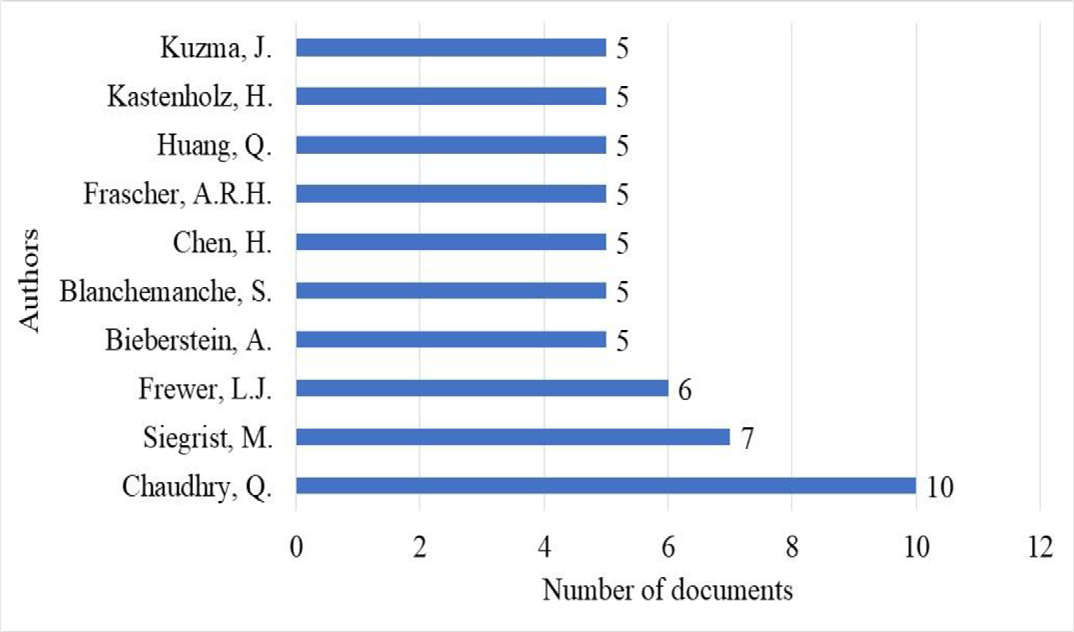
Figure 5:
Most productive authors.
Most cited papers
The 10 most cited articles were also examined, as presented in Table 2. In terms of the most cited sources on the subject of nanotechnology in the food industry, it shows that article produced by Chaudhry et al.[28] and published in the Food Additives and Contaminants – Part A Chemistry, Analysis, Control, Exposure, and Risk Assessment had obtained the highest of 840 citations. The next article by Siegrist et al.[29] which was published in the Appetite had gathered a total of 363 citations. Following this is the article by Chen et al.,[30] published in the journal Food Technology, which had received 252 citations. The remaining seven more articles had accumulated a total of 911 citations. Those articles were authored by Chaudhry et al.[28–31] Siegrist et al.,[32] Chen et al.,[33] Frewer et al.,[34] Bieberstein et al.,[35] and Blanchemanche et al.[36]
| Ranking | Authors with the source (top 10) | Total citations | Total citations per year | References |
|---|---|---|---|---|
| 1 | Applications and Implications of Nanotechnologies for the Food Sector, Food Additives and Contaminants – Part A Chemistry, Analysis, Control, Exposure and Risk Assessment. | 840 | 56 | [28] |
| 2 | Public Acceptance of Nanotechnology Foods and Food Packaging: The Influence of Affect and Trust, Appetite. | 363 | 23 | [29] |
| 3 | Nanotechnology in Nutraceuticals and Functional Foods, Food Technology. | 252 | 15 | [30] |
| 4 | Food Applications of Nanotechnologies: An Overview of Opportunities and Challenges for Developing Countries, Trends in Food Science and Technology. | 222 | 19 | [31] |
| 5 | Perceived Risks and Perceived Benefits of Different Nanotechnology Foods and Nanotechnology Food Packaging, Appetite. | 208 | 14 | [32] |
| 6 | Guidance on Risk Assessment of the Application of Nanoscience and Nanotechnologies in the Food and Feed Chain: Part 1, Human and Animal Health, Efsa Journal. | 154 | 31 | [37] |
| 7 | Acs Select on Nanotechnology in Food and Agriculture: A Perspective on Implications and Applications, Journal of Agricultural and Food Chemistry. | 97 | 11 | [33] |
| 8 | Nanotechnology Applied to European Food Production – A Review of Ethical and Regulatory Issues, Trends in Food Science and Technology. | 82 | 8 | [34] |
| 9 | The Public Understanding of Nanotechnology in the Food Domain: The Hidden Role of Views on Science, Technology, and Nature, Public Understanding of Science. | 74 | 6 | [36] |
| 10 | The Public Understanding of Nanotechnology in the Food Domain: | 74 | 6 | [35] |
Most productive journals
The 426 selected articles were published in 20 different journals. Further analysis was carried out to identify the most productive journals on nanotechnology and food-related research based on the number of citations. The journal of ‘Trends in Food Science and Technology’ appears to be the most productive, with 14 publications and 1764 citations. The second most productive was the RSC Nanoscience and Nanotechnology, with 7 articles and 23 citations. It was worth noting that some journals with fewer publications were also able to receive a high number of citations. For example, the journal Food Technology and Critical Reviews in Food Science and Nutrition published only 5 articles, but the article received 539 and 349 citations, respectively. Similarly, the Journal of Nanoparticle Research had published 5 articles, with the article receiving 219 citations in total. Table 3 explains the top 10 most productive journals on nanotechnology and food-related research.
| Ranking | Sources (top 10) | Total articles | h_index | g_index | m_index | Total citations |
|---|---|---|---|---|---|---|
| 1 | Trends in Food Science and Technology | 14 | 11 | 14 | 0.65 | 1,764 |
| 2 | RSC Nanoscience and Nanotechnology | 7 | 2 | 4 | 0.33 | 23 |
| 3 | Nanotechnology in the Agri-Food Sector: Implications for the Future | 6 | 3 | 6 | 0.25 | 50 |
| 4 | Recent Patents on Food Nutrition and Agriculture | 6 | 5 | 6 | 0.42 | 116 |
| 5 | Agro Food Industry Hi-Tech | 5 | 2 | 2 | 0.15 | 17 |
| 6 | Bio-Nanotechnology: A Revolution in Food Biomedical and Health Sciences | 5 | 2 | 2 | 0.20 | 34 |
| 7 | Critical Reviews in Food Science and Nutrition | 5 | 4 | 4 | 0.31 | 349 |
| 8 | Food Technology | 5 | 5 | 5 | 0.25 | 539 |
| 9 | Journal of Nanoparticle Research | 5 | 5 | 5 | 0.42 | 219 |
| 10 | Nanotechnology in Nutraceuticals: Production to Consumption | 5 | 1 | 1 | 0.14 | 1 |
Most frequent keywords
For the keyword analysis, this study used Biblioshiny to construct a word cloud for the author’s keywords. The top 100 words (or parts of keywords) used in the published article about nanotechnology are shown in Figure 6. The total number of occurrences for the keywords is shown by the size of each word.
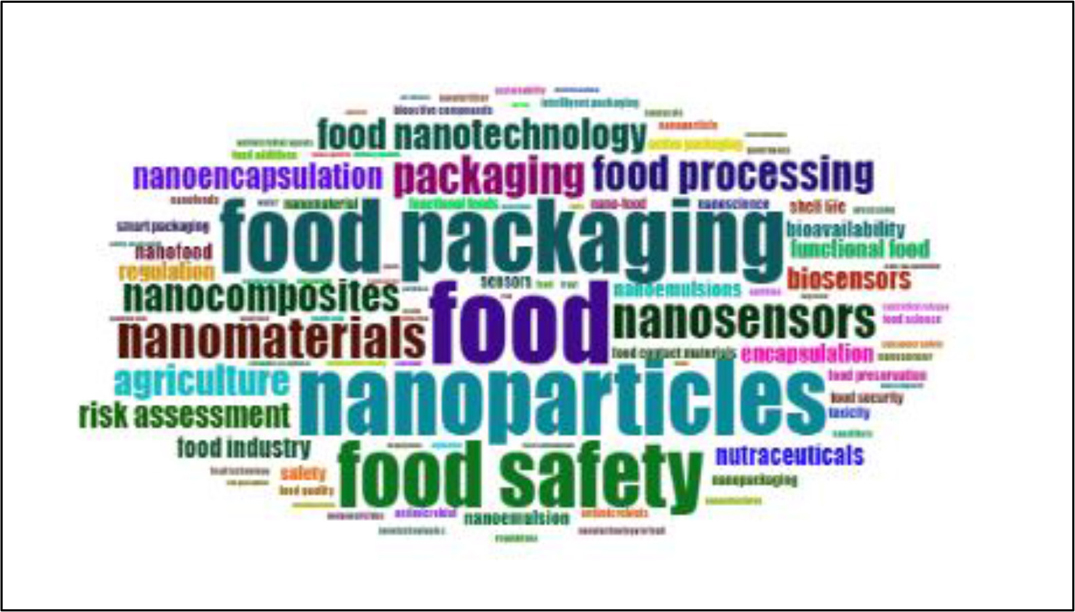
Figure 6:
Word cloud of the author keywords.
It is important to highlight that all of the words generated are the trending words used along with the nanotechnology and food production research. Thus, the authors can predict that future research on nanotechnology can be focused on these keywords.
The word cloud depicts various rising keywords such as nanotechnology, nanoparticles, food packaging, food safety, risk assessment, agriculture, and the food industry, in addition to the keywords that were used to search the title of the paper. Another keyword is the fact that the words have been utilized to accommodate the issue of nanotechnology and food production research, despite their modest size. Table 4 lists the top ten most often occurring keywords.
| Authors keywords (top 10) | Occurrences |
|---|---|
| Nanotechnology | 155 |
| Food | 45 |
| Nanoparticles | 41 |
| Food packaging | 40 |
| Food safety | 36 |
| Nanomaterials | 23 |
| Nanosensors | 22 |
| Packaging | 20 |
| Food processing | 19 |
| Nanocomposites | 18 |
Moving forward, the authors further analyze the keywords for the co-occurrences of it using Biblioshiny. Figure 7 demonstrates the colour, size of the circles, font size, and thickness of the connecting lines signify the intensity of the relationship between the keywords in Biblioshiny’s network visualization of the authors’ keywords.[38] Related keywords are frequently listed together, as shown by the same colour. The blue-coloured nanoparticles, food packaging, food safety, and food processing, for example, appear to be strongly associated and frequently occur together in the Figure 7.
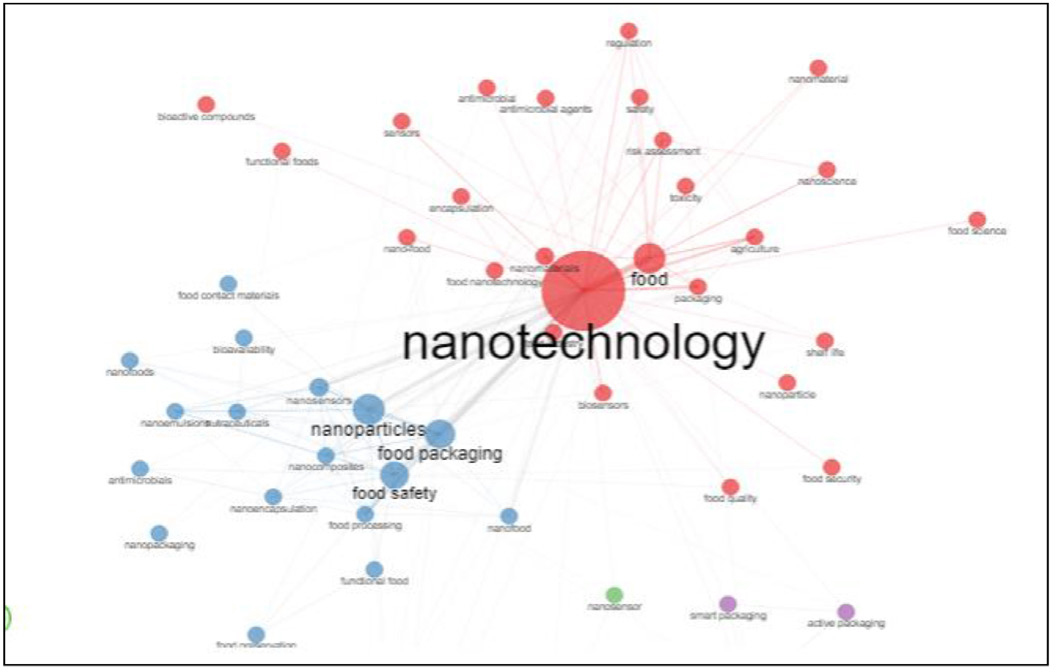
Figure 7:
Co-occurrence analysis of the author keywords.
Country publication trend
Table 5 lists the countries that have examined the topic of nanotechnology and food production. The United States (89) is the highest-ranked country, followed by India (75), the United Kingdom (38) and Italy (29). On the other hand, Brunei, Croatia, Singapore, Sweden, and Qatar are among the countries that have made fewer contributions on this topic (blue shading in Figure 8). According to the findings, the research topic is being studied extensively by both established technology solution countries and countries with the largest nanotech solutions impacting food and agriculture. This is a great example of countries paying attention to each other and cooperating.
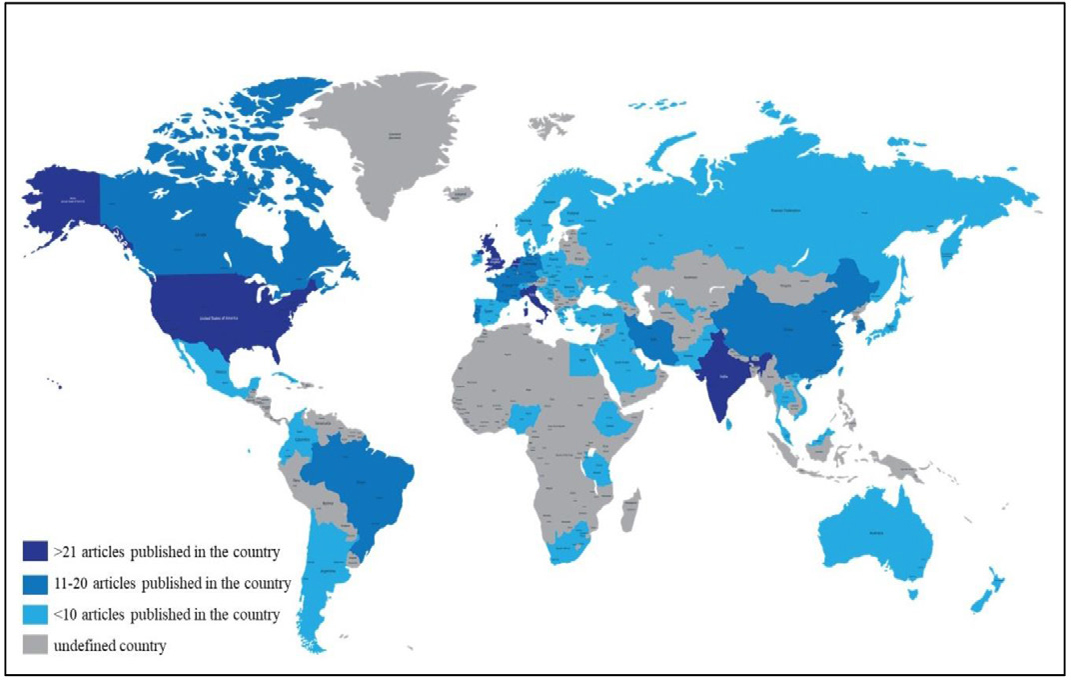
Figure 8:
Country publication trend.
| Country | Number of articles |
|---|---|
| United States | 89 |
| India | 75 |
| United Kingdom | 38 |
| Italy | 29 |
| Netherland | 22 |
| China | 19 |
| South Korea | 19 |
| Canada | 16 |
| Belgium | 14 |
| Germany | 14 |
DISCUSSION AND IMPLICATIONS
The nanotechnology and food production research stream has been examined by several authors. The most prominent journals are also highlighted in this study. The three most prestigious journals are Trends in Food Science and Technology, RSC Nanoscience and Nanotechnology, and Nanotechnology in the Agri-Food Sector: Implications for the Future. While papers in Trends in Food Science and Technology and RSC Nanoscience and Nanotechnology focus on food science, current technology, and human nutrition, research on nanotechnology in agricultural and food science is included in the other journal.
The authors were able to obtain important information from the bibliometric analysis. Based on this study analysis, only a few studies explore nanotechnology in food production. In a society that is becoming increasingly concerned about food safety, quality, and security, the relationship between nanotechnology and food production will need to be investigated further in the future. Hence, researchers should look at the role of nanotechnology in food production for improving food sustainability, (ii) how food industries may sustainably convert their food processes, and (ii) the influence of an increase in demand for both quality and sustainable food. Furthermore, there is little discussion of the Sustainable Development Goals (SDGs) and their importance in enhancing long-term food safety, quality, and security awareness. Accordingly, researchers should adopt the main drive of SDG 9 and SDG 12 on industrial innovation and infrastructure, and responsible consumption and production to explore the role of food production in ensuring long-term food safety, quality, and security.
Moreover, the findings of this study allow for the discovery of a link between food production and essential components of nanotechnology progress. Anser et al.[39] address the favourable effects of food production on firm performance and sustainability through technology innovation. Similarly, Saari et al.[40] stress the need of the food sector for technological innovation. Therefore, the nanotechnology and food production research stream are emerging.
CONCLUSION AND LIMITATION
Nanotechnology is expanding rapidly for its applications in the food industry. Nanotechnology has already been used to increase the efficiency and effectiveness of supply chain processes related to food quality, handling, packaging, and safety. At the same time, nanotechnologies in most food supply chain-related applications are still in the research and development stage Therefore, a bibliometric analysis was performed considering the importance of nanotechnology in the production of foods. Numerous studies on the topic were reported, highlighting nanotechnology has potential applications in the food supply chain.
Using bibliometric analysis, this study analyses 426 journal publications in the nanotechnology and food production research stream. The investigation yielded some interesting results. Nanotechnology and food production information, for example, is divided into five categories: nanotechnology applications, food safety, food packaging, nanoparticle awareness, and food processing. Besides, the primary bibliometric indicators are obtained using a quantitative approach. In the 19-year sample period, the authors discover 401 authors who discuss nanotechnology and food production. Additionally, there is a suggestion of author collaborations between countries and institutions.
This study has several consequences for both academics and practitioners. The study research stream reveals a robust link between nanotechnology application and food production. Alike, more investigation into their relationship with sustainability in the context of the SDG agenda could be conducted. The method utilized has a further theoretical implication. This study presents a strong and organized methodology that may be applied directly to the nanotechnology and food production industries. Additionally, nanotechnology in food production, in the eyes of practitioners drives beyond being considered a technological innovation adoption, instead begins to create innovative technology. Furthermore, food industry decision-makers may find this study’s findings useful in ensuring great food production service in their facilities and promoting sustainability as an innovation source. The findings could be used as a starting point for food manufacturers and other stakeholders in the food systems to implement technologies as an opportunity in their production system to improve supply chain visibility, food integrity, tracking, and traceability.
Researchers will have easy access to information on various trends, themes, and research streams on nanotechnology in food production as a result of this study contribution. However, there are several limitations to this research. First, the authors only examined the bibliometric data of papers, not the complete content. Even though it is expected that the keywords employed represent the core substance of the documents, there may be some limits. Therefore, combining this sort of literature review with a traditional review would boost the total value of such investigations. Second, although the authors coded the sample articles independently throughout the cluster analysis, this study relied solely on Scopus as a research database, which could lead to a bias in paper assignment to clusters. Thus, other journal databases should be considered in future studies. Finally, the database search was limited to publications published in English. The sample examined in this study does not include publications in other languages. Future research should consider other languages. Despite these flaws, this study provides useful information about the present state of knowledge of nanotechnology in food production. Hence, the authors anticipate that this contribution will help intellectual capital academics focus on future research that will have a significant impact, particularly on sustainable food product development.
ACKNOWLEDGEMENT
Authors would like to acknowledge the Ministry of Higher Education Malaysia for funding this project through Fundamental Research Grant Scheme (FRGS) with project code FRGS/1/2021/ SS01/UCSI/03/1. In addition, this project is funded in part by Universiti Teknologi MARA (UiTM) with Project ID: 600-RMC/ GPM SS 5/3 (077/2021).
References
- Derviş H. Bibliometric analysis using bibliometrix an R package. Journal of Scientometric Research. 2019;8(3):156-60. [Google Scholar]
- Schwirn K, Tietjen L, Beer I. Why are nanomaterials different and how can they be appropriately regulated under REACH?. Environmental Sciences Europe. 2014;26(1):1-9. [Google Scholar]
- Quinteros MA, Aristizábal VC, Dalmasso PR, Paraje MG, Páez PL. Oxidative stress generation of silver nanoparticles in three bacterial genera and its relationship with the antimicrobial activity. Toxicology in vitro. 2016;36:216-23. [Google Scholar]
- Zhang L, Wu L, Si Y, Shu K. Size-dependent cytotoxicity of silver nanoparticles to Azotobacter vinelandii: Growth inhibition, cell injury, oxidative stress and internalization. PLoS One. 2018;13(12):e0209020 [Google Scholar]
- Rai M. Smart nanopackaging for the enhancement of food shelf life. Environ. Chem Lett. 2019;17:277-90. [Google Scholar]
- Dash KK, Deka P, Bangar SP, Chaudhary V, Trif M, Rusu A, et al. Applications of inorganic nanoparticles in food packaging: A Comprehensive Review. Polymers (Basel). 2022;14(3):521 [Google Scholar]
- Anvar AA, Ahari H, Ataee M. Antimicrobial properties of food nanopackaging: A new focus on foodborne pathogens. Front Microbiol. 2021;12:690706 [Google Scholar]
- Li Y, Wang Z, Sun L, Liu L, Xu C, Kuang H, et al. Nanoparticle-based sensors for food contaminants. TrAC Trends Anal Chem. 2019;113:74-83. [Google Scholar]
- Ling EK, Wahab SN. Integrity of food supply chain: going beyond food safety and food quality. International Journal of Productivity and Quality Management. 2020;29(2):216-32. [Google Scholar]
- Ahmi A, Tapa A, Hamzah AH. Mapping of financial technology (FinTech) Research: A bibliometric analysis. Int J Adv Sci Technol. 2020;29(8):379-92. [Google Scholar]
- Durieux V, Gevenois PA. Bibliometric indicators: quality measurements of scientific publication. Radiology. 2010;255(2):342-51. [Google Scholar]
- Aleixandre-Tudó JL, Bolaños-Pizarro M, Aleixandre JL, Aleixandre-Benavent R. Worldwide scientific research on nanotechnology: a bibliometric analysis of tendencies, funding, and challenges. J Agric Food Chem. 2020;68(34):9158-70. [Google Scholar]
- Idamokoro EM, Hosu YS. Global Research Trends on the Use of Nanotechnology to Boost Meat Production: A Scientometric Analysis. Front Res Metrics Anal. 2022;6:793853 [Google Scholar]
- Ribeiro NG. Dairy foods and novel thermal and non-thermal processing: a bibliometric analysis. Innov Food Sci and Emerg Technol. 2022;76:102934 [Google Scholar]
- Martínez-Ruiz V, Valenzuela-Martínez M, Lardelli-Claret P, Molina-Soberanes D, Moreno-Roldán E, Jiménez-Mejías E, et al. Factors related to the risk of pedestrian fatality after a crash in Spain, 1993-2013. J Transp & Heal. 2019;12:279-89. [Google Scholar]
- Pritchard A. Statistical bibliography or bibliometrics. J Doc. 1969;25:348 [Google Scholar]
- Liang TP, Liu YH. Research landscape of business intelligence and big data analytics: A bibliometrics study. Expert Syst Appl. 2018;111:2-10. [Google Scholar]
- Ren M, Yu X, Mujumdar AS, Yagoub AEGA, Chen L, Zhou C, et al. Visualizing the knowledge domain of pulsed light technology in the food field: A scientometrics review. Innov Food Sci Emerg Technol. 2021;74:102823 [Google Scholar]
- Doa US. Nanoscale science and engineering for agriculture and food systems: a report submitted to cooperative state research, education and extension service. Washington, DC Dep Agric. 2003 [Google Scholar]
- Mongeon P, Paul-Hus A. The journal coverage of Web of Science and Scopus: a comparative analysis. Scientometrics. 2016;106:213-28. [Google Scholar]
- Hong JH. Characteristics of the most cited, most downloaded, and most mentioned articles in general medical journals: a comparative bibliometric analysis. In Healthcare. 2020;8(4):492 [Google Scholar]
- Morrissey S. Nanotechnology in food and agriculture. Chem Eng News. 2006;84:31 [Google Scholar]
- Nile SH, Baskar V, Selvaraj D, Nile A, Xiao J, Kai G, et al. Nanotechnologies in food science: applications, recent trends, and future perspectives. Nano-micro Lett. 2020;12:1-34. [Google Scholar]
- Adeyeye SAO, Fayemi OE. Nanotechnology and food processing: Between innovations and consumer safety. J Culin Sci Technol. 2019;17(5):435-52. [Google Scholar]
- Espitia PJP, Otoni CG. Nanotechnology and edible films for food packaging applications. Bio-based Mater. Food Packag. Green Sustain. Adv Packag Mater. ;2018:125-45. [Google Scholar]
- Neme K, Nafady A, Uddin S, Tola YB. Application of nanotechnology in agriculture, postharvest loss reduction and food processing: Food security implication and challenges. Heliyon. 2021;7(12) [Google Scholar]
- Pushparaj K. Nano-from nature to nurture: A comprehensive review on facets, trends, perspectives and sustainability of nanotechnology in the food sector. Energy. 2022;240:122732 [Google Scholar]
- Chaudhry Q. Applications and implications of nanotechnologies for the food sector. Food Addit Contam. 2008;25(3):241-58. [Google Scholar]
- Siegrist M, Cousin ME, Kastenholz H, Wiek A. Public acceptance of nanotechnology foods and food packaging: The influence of affect and trust. Appetite. 2007;49(2):459-66. [Google Scholar]
- Chen H, Weiss J, Shahidi F. Nanotechnology in nutraceuticals and functional foods. Food Technol. 2006;60(3):30-6. [Google Scholar]
- Chaudhry Q, Castle L. Food applications of nanotechnologies: an overview of opportunities and challenges for developing countries. Trends Food Sci Technol. 2011;22(11):595-603. [Google Scholar]
- Siegrist M, Stampfli N, Kastenholz H, Keller C. Perceived risks and perceived benefits of different nanotechnology foods and nanotechnology food packaging. Appetite. 2008;51(2):283-90. [Google Scholar]
- Chen H, Seiber JN, Hotze M. ACS select on nanotechnology in food and agriculture: a perspective on implications and applications. Journal of Agricultural and Food Chemistry. ACS Publications. 2014;62(6):1209-12. [Google Scholar]
- Coles D, Frewer LJ. Nanotechnology applied to European food production-A review of ethical and regulatory issues. Trends food Sci & Technol. 2013;34(1):32-43. [Google Scholar]
- Bieberstein A, Roosen J, Marette S, Blanchemanche S, Vandermoere F. The effect of information choice and discussion on consumer willingness-to-pay for nanotechnologies in foud. J Agric Resour Econ Agric Econ Assoc [Milwaukee, Wis.]-Bozeman, Mont., 1992, currens. 2011;36(2):363-74. [Google Scholar]
- Vandermoere F, Blanchemanche S, Bieberstein A, Marette S, Roosen J. The public understanding of nanotechnology in the food domain: the hidden role of views on science, technology, and nature. Public Underst Sci. 2011;20(2):195-206. [Google Scholar]
- Committee ES. Guidance on risk assessment of the application of nanoscience and nanotechnologies in the food and feed chain: Part 1, human and animal health. EFSA J. 2018;16(7):e05327 [Google Scholar]
- Van Eck NJ, Waltman L. Citation-based clustering of publications using CitNetExplorer and VOSviewer. Scientometrics. 2017;111:1053-70. [Google Scholar]
- Anser MK, Khan MA, Nassani AA, Aldakhil AM, Hinh Voo X, Zaman K, et al. Relationship of environment with technological innovation, carbon pricing, renewable energy, and global food production. Econ Innov New Technol. 2021;30(8):807-42. [Google Scholar]
- Saari UA, Herstatt C, Tiwari R, Dedehayir O, Mäkinen SJ. The vegan trend and the microfoundations of institutional change: A commentary on food producers’ sustainable innovation journeys in Europe. Trends food Sci & Technol. 2021;107:161-7. [Google Scholar]

